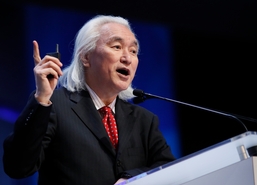Imagining the Future
Friday, Dec. 01, 2017
In a lively presentation Thursday afternoon, Michio Kaku, PhD, engaged the audience in a humorous and entertaining walk into the future through the eyes of a theoretical physicist.
Dr. Kaku identified three waves of wealth generation in modern economies: The first was the invention of steam power in the 1800s, next came the discovery of electricity. The third wave brought high tech innovations including transistors, lasers and the space program.

“So, what is the fourth wave?” he asked. It is advancements at the molecular level — in particular, artificial intelligence (AI), nanotech and biotech all linked together by the cloud.
In the future envisioned by Dr. Kaku, we will live in a combination of virtual and augmented reality, allowing us to create imaginary worlds while extracting vital information instantly. He described this concept as “information everywhere and nowhere.”
“Life will be a lot easier as a consequence of information everywhere—and nowhere,” he said. “We can already put information in glasses and access it. Physicians can use the technology during a surgical procedure.”
But those glasses can become awkward. So eventually, said Dr. Kaku, the internet contact lens will be developed, giving everyone instant access to information. Imagine, he said, you are at RSNA and you run into an acquaintance. Normally you might become frustrated searching your memory for the person’s name.
“In the future, you will blink and be online,” he said. Instant access to that elusive name.
Memorizing, the hallmark of education as we know it—particularly in medical education—becomes unnecessary.
Possibilities and Limitations of AI
Acknowledging that AI is the current innovation that appears to be poised to replace jobs across industry and skill level, he also reminded the audience that there are significant limitations to what AI can actually do and that robots cannot entirely replace skilled and semi-skilled workers.
“Robots are weak in three areas,” Dr. Kaku said.
The first is pattern recognition. Robots can see lines and squares, but they cannot recognize things like a table. The second is common sense. For example, a robot doesn’t know water is wet or that mothers are older than their daughters. Computers do not know such things on their own, the information has to be programmed.
The third weakness of robots, Dr. Kaku said, is in handling human interactions. Robots, he said, can’t argue a legal case or understand morals and values.
The human brain, on the other hand, has no CPU and requires no programming or subroutines. “So what is a brain?” he asked. You can remove half the brain from a human and that human can still function quite well. Remove one transistor from a computer and it crashes.
“Many AI systems will aid humans, not replace them,” Dr. Kaku said. He added that the brain is a learning machine, and it is difficult to train computers to emulate thinking. Humans have the advantage of intuition and experience.
So the winners in this new economy he said, are the intellectual capitalists because they know the three weaknesses of robots. If your job is to read x-rays every day, a robot may be able to do it better, Dr. Kaku speculated. “But when the chips are down, when you have to apply intuition and experience, that’s where you win,” he said.
Digitization of Medicine
Dr. Kaku reminded the audience that in the 1970s President Nixon declared a war on cancer. It failed, he said, because we did not have a road map, nor did we have lasers, computers and the Genome Project.
Now we know cancer is a disease of genes, but we still have no way of detecting cancer until a tumor develops. A liquid biopsy can identify genes and proteins in blood and detect cancer years before a tumor forms. In fact, he predicted, the word “tumor” will disappear in the future.
Researchers have the ability to grow human skin, blood, heart valves and more from stem cells. Dr. Kaku showed an image of a beating mouse heart grown from stem cells. Cartilage grown from stem cells can help treat arthritis in an aging population.
Digitizing the Human Mind
The next big science project to be tackled is to map the human brain, the Human Connectome Project, according to Dr. Kaku.
That capability will open up new opportunities in medicine. Researchers can map neural pathways and extract images from a living brain.
The U.S. Pentagon is funding $150 million to connect a living brain with an exoskeleton, he said. The map will provide the blueprint to do this, providing new treatments for injured soldiers and athletes.
Eventually, he said, we might have brain pacemakers for Alzheimer’s patients, uploading memories that would be otherwise lost.




 Home
Home Program
Program
 Exhibitors
Exhibitors My Meeting
My Meeting
 Digital Posters
Digital Posters Case of Day
Case of Day

